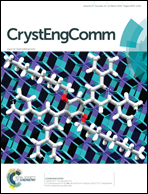Preparation, optical property and field-effect mobility investigation of stable white-emissive doped organic crystal†
Abstract
Different from most reported white-light-emission amorphous doped organic films obtained through precisely controlling a very low and specific doping concentration usually smaller than 1%, tetracene (Tc) and pentacene (Pc) doubly doped trans-1,4-distyrylbenzene (DSB) crystals (DSB⊂Tc–Pc), prepared by physical vapor transport (PVT) method presented a white-light emission with approximately 10 mol% dopant concentrations (DSB : Tc : Pc = 20 : 1 : 0.9). This is attributed to the intermolecular strong arene–arene interactions inducing a cross donor–acceptor transition dipole arrangement, that is efficient in restricting energy transfer. The time-resolved fluorescence properties have been investigated in detail to analyze the energy transfer process between DSB and Tc/Pc molecules in the DSB⊂Tc–Pc crystal. In addition, the maintenance of structural ordering of the white-emissive doped crystal has been verified by atomic force microscopy (AFM) and X-ray diffraction (XRD), which benefits the carrier transport; the hole and electron field-effect mobility were measured as 1.62 × 10−2 and 2.15 × 10−4 cm2 V−1 s−1, respectively. Also due to the intermolecular highly ordered arrangement, the DSB⊂Tc–Pc crystal exhibits ideal and stable white-light emission with CIE coordinates approaching to (0.33, 0.33) even under high pumping laser energy excitation. These results indicate the stable white-emissive doped organic crystals can be prepared by PVT and has high potential of realizing white electroluminescence based on the device configurations of light-emitting diodes or field-effect transistors.


 Please wait while we load your content...
Please wait while we load your content...